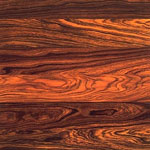Serving Upstate NY—VT—MA • For selections & prices, CALL or EMAIL US
Cocobolo (Rosewood)
Grades & Properties of Wood Flooring —
Exotic Species
Scientific Name:
Dalbergia retusa
Other Common Names and Related Species:
- Caviuna
- Cocobolo Prieto
- Funeram
- Granadillo
- Jacarandáholz
- Nambar
- Nicaraguan Rosewood
- Palisander
- Palisandro
- Palissandre
- Palissandro
- Palo Negro
- Pau Preto
- Rosewood
- Urauna
Shop online now for Cocobolo Flooring »
Origin:
Nicaragua produces the best Cocobolo Rosewood, but supply is sporadic in South America.
Janka Hardness: 1136
Cocobolo is 60% harder than Douglas-fir, 16% softer than White Oak, and 51% as hard as Santos Mahogany.
Grades of Cocobolo Flooring:
Clear grade Cocobolo Rosewood flooring is color-sorted for a red, orange, and brown color with pronounced brown and black grain. It is a true rosewood and very desirable and expensive. Most Rosewoods are endangered and not available in flooring. Our Cocobolo flooring is grown on a renewable plantation. There are other beautiful species that are called “Rosewood,” like Morado — which is rare in itself — but it should not to be confused with Cocobolo. There is a highly figured “King” grade of Cocobolo flooring, which demands an even higher price.
Cocobolo Flooring Dimension Specifications:
Some Cocobolo flooring is milled in South America because it is more cost-effective to ship finished material than raw lumber. Lengths of the Cocobolo flooring bundles are 7 feet so they can easily fit into 8-foot-wide steel shipping containers. All pre-milled products are tongue-&-groove and end-matched (tongue-&-grooved on the ends of the boards). Moisture content ranges from 6% to 8% for quick acclimation. The average length of the flooring pieces is usually about 3 feet and ranges from 1 to 7 feet. Almost all imported flooring that is found is in 7-foot bundles, with widths available from 2¼″ to 5″. Typically, if a long or wide plank floor is desired, raw lumber must be obtained and the flooring must be milled here in the United States. Typically, the lengths can develop up to 12 feet. However, the cost can be double that of the pre-milled stock because of waste and labor costs in the United States. Also, raw lumber is relatively expensive because it is taxed more heavily than finished products to support local economies in South America. Most of the time Cocobolo flooring is milled in here in the U.S., but pricing is about the same as pre-milled, which is extremely expensive.
Flooring Availability:
Cocobolo flooring is available almost exclusively unfinished in ¾″ solid form. It can be prefinished or engineered by extreme custom order. Cocobolo is extremely rare in comparison with many Brazilian species such as Brazilian Cherry. There is a very limited amount of Cocobolo in South America, and it is almost endangered. Again, our Cocobolo is plantation harvested. Less logging, stricter regulations, and a slower American economy have limited commodities and caused slightly higher prices of this product in this country, but it is still available.
Finished Floor Appearance:
A Clear grade floor will have a busy overall orange, black, and brown appearance. Cocobolo flooring darkens somewhat with exposure to sunlight but is dark unfinished. Oil-based finishes allow Cocobolo to age to a deeper brown color; however, lacquer or de-waxed shellac should be first applied to help to aid in drying because of the oily nature of the wood. Water-based finishes will preserve the natural color longer but can appear milky in appearance because of the darkness of the wood.
Flooring Durability and Stability:
Cocobolo flooring is extremely durable and resists denting and traffic wear quite well. It is much harder than North American species because of its density and is relatively stable. Cocobolo flooring is heavy, weighing about 3 pounds per square foot.
Workability of Cocobolo Flooring:
Although hard and tough, Cocobolo works with little difficulty with both hand and power tools. When installing the Morado flooring, it is best to use a manual nailer, but staples and pneumatic nailers can be used. It holds screws well, and it glues, stains, and polishes to a very attractive finish. It can be somewhat difficult to sand with flooring equipment because of its hardness. Professional sanding and finishing is recommended. This wood is very resistant to decay and insects; these resistant properties may contribute to a possible allergic response to the dust. To avoid a possible allergic reaction to the material, wear a dust mask and long-sleeve shirt when working with Cocobolo.
Principal Uses of Cocobolo Flooring:
Cocobolo flooring is used in high-end residential and commercial applications for a dramatically elegant floor. It works well in rustic camps as well as in contemporary structures. There is no other floor that is similar.





